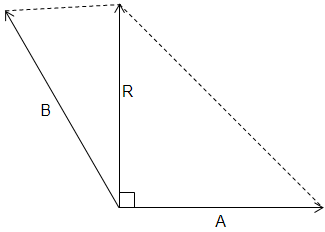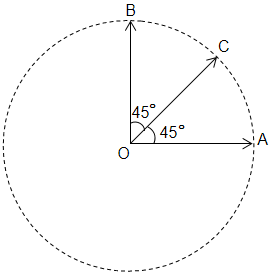A force of 6 N and another of 8 N can be applied together to produce the effect of a single force of -
(1) 1 N
(2) 11 N
(3) 15 N
(4) 20 N
Which of the sets given below may represent the magnitude of resultant of three vectors adding to zero?
(1) 2, 4, 8
(2) 4, 8, 16
(3) 1, 2, 1
(4) 0.5, 1, 2
A blind person after walking 10 steps in one direction, each of length 80 cm, turns randomly to the left or to the right by 90°.90°. After walking a total of 40 steps the maximum possible displacement of the person from his starting position could be -
(1) 320 m
(2) 32 m
(3) 16/√2 m
(4) 16√2 m
The resultant of two vectors A and B is perpendicular to the vector A and its magnitude is equal to half the magnitude of vector B. The angle between A and B is -

1. 120°
2. 150°
3. 135°
4. None of these
The three vectors OA, OB and OC have the same magnitude R. Then the sum of these vectors have magnitude -

1. R
2. √2R
3. 3R
4. (1+√2)R
A truck travelling due north with 20m/s turns towards west and travels at the same speed. Then the change in velocity is -
(1) 40 m/s north-west
(2) 20√2 m/s north-west
(3) 40 m/s south-west
(4) 20√2 m/s south-west
A particle is moving in a circle of radius r centered at O with constant speed v. The change in velocity moving from A to B (∠AOB=40°) is -
(A) 2v cos 40°
(B) 2v sin 40°
(C) 2v cos 20°
(D) 2v sin 20°
What is the resultant of three coplanar forces: 300 N at 0°, 400 N at 30° and 400 N at 150°?
1. 500 N
2. 700 N
3. 1100 N
4. 300 N
Two forces, F1 and F2 are acting on a body. One force is doubled of the other force and the resultant is equal to the greater force. Then the angle between the two forces is -
(A) cos-1 (1/2)
(B) cos-1 (-1/2)
(C) cos-1 (-1/4)
(D) cos-1 (1/4)
If the angle between vector a and b is an acute angle, then the difference a-b is -
(1) the main diagonal of the parallelogram
(2) the minor diagonal of the parallelogram
(3) any of the above
(4) none of the above






